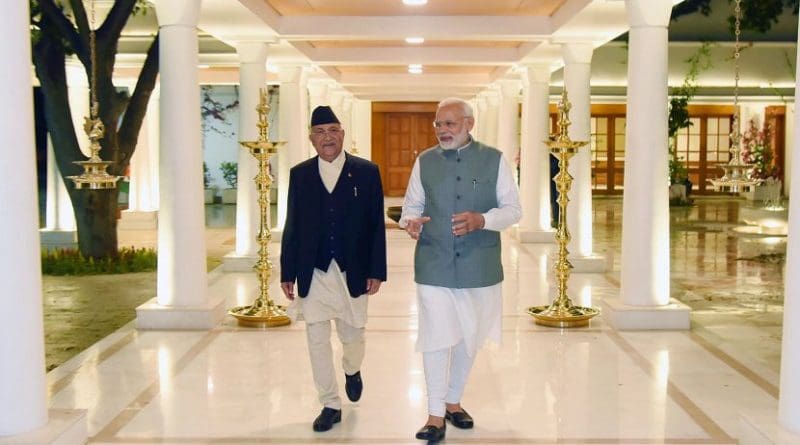Oli’s Delhi Visit: A Milestone In Nepal-India Relations – Analysis
By Observer Research Foundation
By Hari Bansh Jha
Governments in Nepal and India keep on changing, but the people-to-people relations between the two countries continue to remain evergreen. At times the relations between these two closest neighbours with open border system sour at the government-to-government level, but because of certain inbuilt mechanism of course corrections it soon get adjusted. This was well reflected during the Nepalese Prime Minister KP Sharma Oli’s recent visit to New Delhi between 6 and 8 April.
While in New Delhi, PM Oli, along with his counterpart Narendra Modi, inaugurated the Integrated Check Post (ICP) at Birgunj, apart from the 69-km Amlekhganu-Motihari oil pipeline. The two countries also agreed to expedite the much-delayed Pancheshwar, Terai road and other infrastructure related projects.
Operationalisation of the ICP is expected to increase the volume of cross-border trade. It is also likely to facilitate the movement of people from one country to the other. Similarly, the oil pipeline will deliver two million tonnes of petrol to Nepal per annum, which could remove major constraints in the transportation of oil from India to Nepal.
The country is not only self-sufficient in the production of food grains, but it is also one of the exporters of foodgrains. It has also emerged as the largest producer of milk and milk products. All this is possible because of green and white revolution in the country.
Given such realities, Nepal’s interest to enter into a partnership with India in agricultural sector could help this country to learn as to how to increase production and productivity in the agriculture, livestock and fisheries sectors. Production and exports of such agricultural products in the county could help bridging the gap in the balance of trade with India. Available data show that Nepal’s deficit in balance of trade with India amounted to NRs. 491 billion in the first 10 months of 2016-17, which is quite huge.
Another landmark agreement between Nepal and India was to enhance connectivity through Inland Waterways. This could provide the landlocked country access to the sea. As the transportation cost through the waterways is often far lower than transportation through other modes, this could boost up Nepal’s trade with India and third countries. And, more than this, the country now would no more remain landlocked with this development because of its access to the sea.
With the completion of this vital project, Kathmandu will be linked to over 115,000 kilometres of Indian railway system, which happen to be one of the largest rail networks at the global level. Both time and cost-wise, it will be far easier to travel to Kathmandu from the Terai region and also from India. Even the transport cost of carrying goods from Terai or India to Kathmandu will be far less. With this development, the volume of business and trade within the country as well as with India and the third countries would increase at faster rate.
Additionally, the Raxaul-Kathmandu railway link will have greater strategic importance. Experts believe that this project is likely to counter China’s 8 billion dollar railway project under Belt and Road Initiative that is intended to link Tibetan railway through Rasuwagadhi-Kerung border to Kathmandu and further to Pokhara and Lumbini. In certain quarters, it is feared that the Chinese railway system could compel Nepal to remain in perpetual debt and thereby surrender part of its sovereignty to China. A poor country like Nepal is not in a position to repay the interest and principal amount of such a huge loan. If at all this railway project would benefit any country, it is China alone. There is very little that Nepal could export to China. But there will be quite a lot of products that Nepal would have to import from that country. This will further tend to worsen our balance of trade with China.
This was in regard to the 2.5 billion dollars Budhi Gandaki Hydroelectric project. Initially, the contract for this project had been awarded to China Gezhouba Group Corporation. But former Prime Minister Sher Bahadur Deuba cancelled this contract to the Chinese company for its failure to meet the requirements. Soon afterwards, Oli gave a statement that he could renew the contract to the Chinese company that is expected to produce 1200 MW of power. It will be difficult to make this project sustainable if India refuses to buy power.
PM Oli’s visit would have been more fruitful if he had made agreement with India for the construction of Sapt Koshi High Dam, 900 MW Arun III project and the 600,000 MW Pancheshwar Project. He would also have been more popular if he were to make a deal with India in regard to exchanging the banned notes of Rs. 500 and Rs. 1000 denominations. Such notes were demonetised in India in November 2016. Since the Nepalese were allowed to hold such high-value notes from 2014, many of them possessed those currencies. Following the demonetisation of such notes, certain sections of the Nepalese who had connections with India managed to convert the old notes into new ones. Yet, there were many people who could not do so. Officially, Nepal has over IRs. 300 million of such notes. But the unofficial account is that there is over IRs.10 billion worth of such notes in the country.
Yet, to the great satisfaction of the Nepalese, all such major deals that have been made in New Delhi this time — be it related to the joining Raxaut to Kathmandu through the railways, access to the sea through inland waterways, the oil-pipeline connection between the two countries or ICP in Birgunj — would prove a milestone in Nepal’s development efforts. Possibly, those deals that could not be made this time in New Delhi might be done when Indian PM Narendra Modi would visit Kathmandu. Thus, on the whole, the visit to New Delhi by the Nepalese Prime Minister could be taken as successful.

